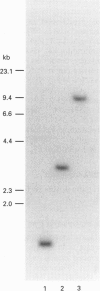Abstract
Diadenosine 5',5"'-P1,P4-tetraphosphate (Ap4A) asymmetric hydrolase (EC 3.6.1.17) is a specific catabolic enzyme of Ap4A found in Schizosaccharomyces pombe. We have previously described the partial purification of Ap4A hydrolase from S. pombe [Robinson, de la Peña and Barnes (1993) Biochim. Biophys. Acta 1161, 139-148]. We determined the sequence of the N-terminal 20 amino acids of Ap4A hydrolase and designed two degenerate PCR primers based on the sequence. The 60 bp DNA fragment obtained by PCR, which is specific to Ap4A hydrolase, was used to isolate the Ap4A hydrolase gene, aph1, from S. pombe by screening a genomic DNA library in a multicopy plasmid. Ap4A hydrolase activity from the crude supernatant of a positive S. pombe transformant was about 25-fold higher than the control. There was no detectable stimulation of enzymic activity by phosphate. The aph1 gene from S. pombe contains three introns. The intron boundaries were confirmed by sequencing the cDNA of the aph1 gene from a S. pombe cDNA library. The deduced open reading frame of the aph1 gene codes for 182 amino acids. Two regions of significant local similarity were identified between the Ap4A hydrolase and the histidine triad (HIT) protein family [Séraphin (1992) DNA Sequence 3, 177-179]. HIT proteins are present in prokaryotes, yeast, plants and mammals. Their functions are unknown, except that the bovine protein inhibits protein kinase C in vitro. All four histidine residues which are conserved among the HIT proteins, including the HxHxH putative Zn(2+)-binding motif, are conserved in the Ap4A hydrolase. In addition, there are two regions of similarity between the Ap4A phosphorylases I and II from Saccharomyces cerevisiae and Ap4A hydrolase from S. pombe. These regions overlap with the HIT protein similarity regions. The aph1 gene from S. pombe is the first asymmetrical Ap4A hydrolase gene to be cloned and sequenced.
Full text
PDF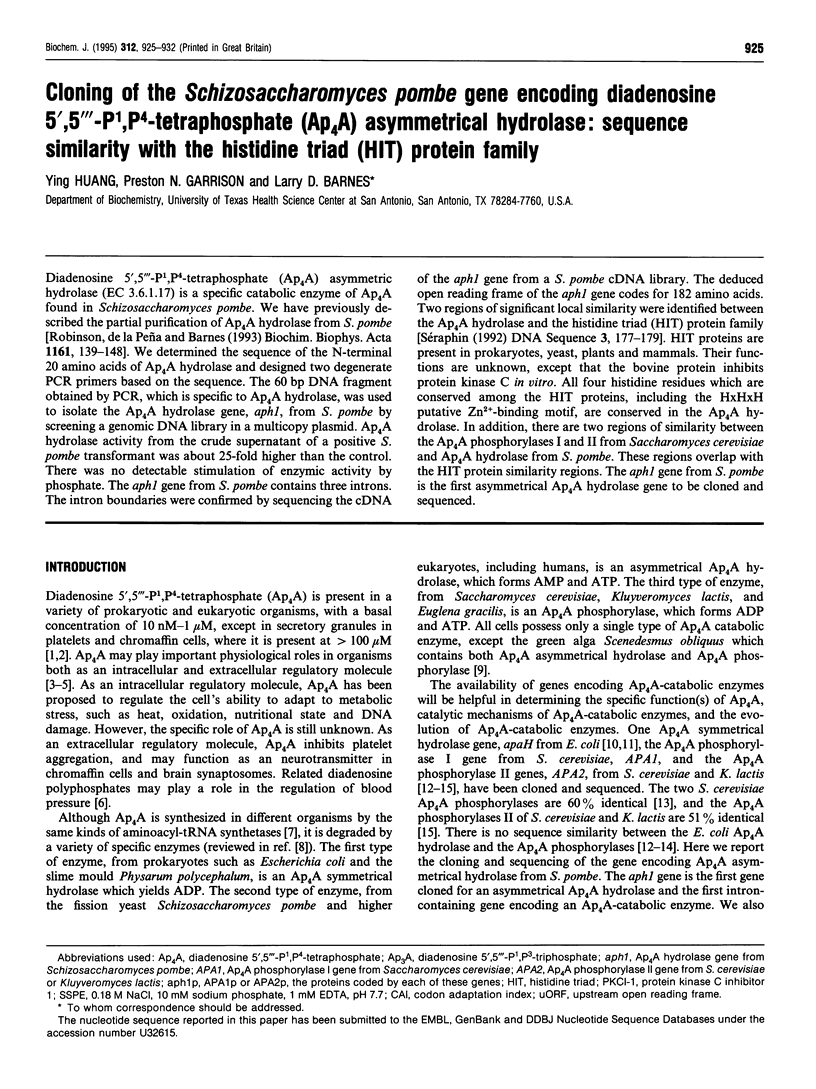
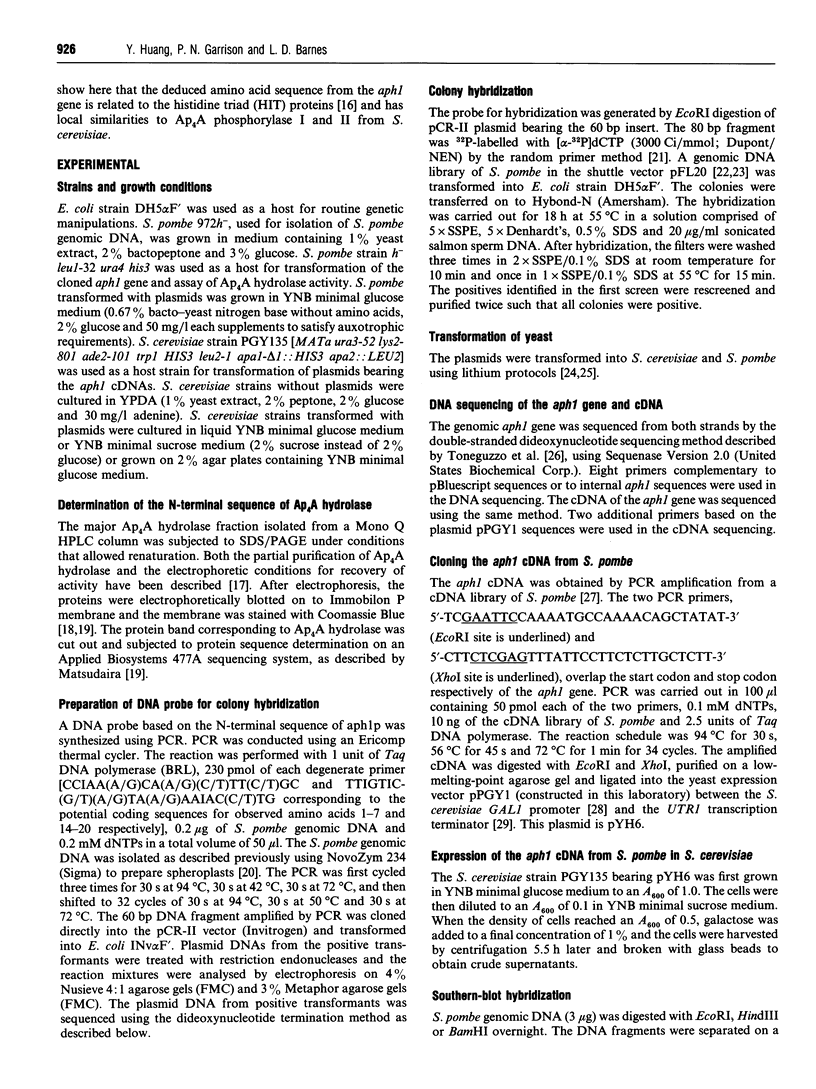
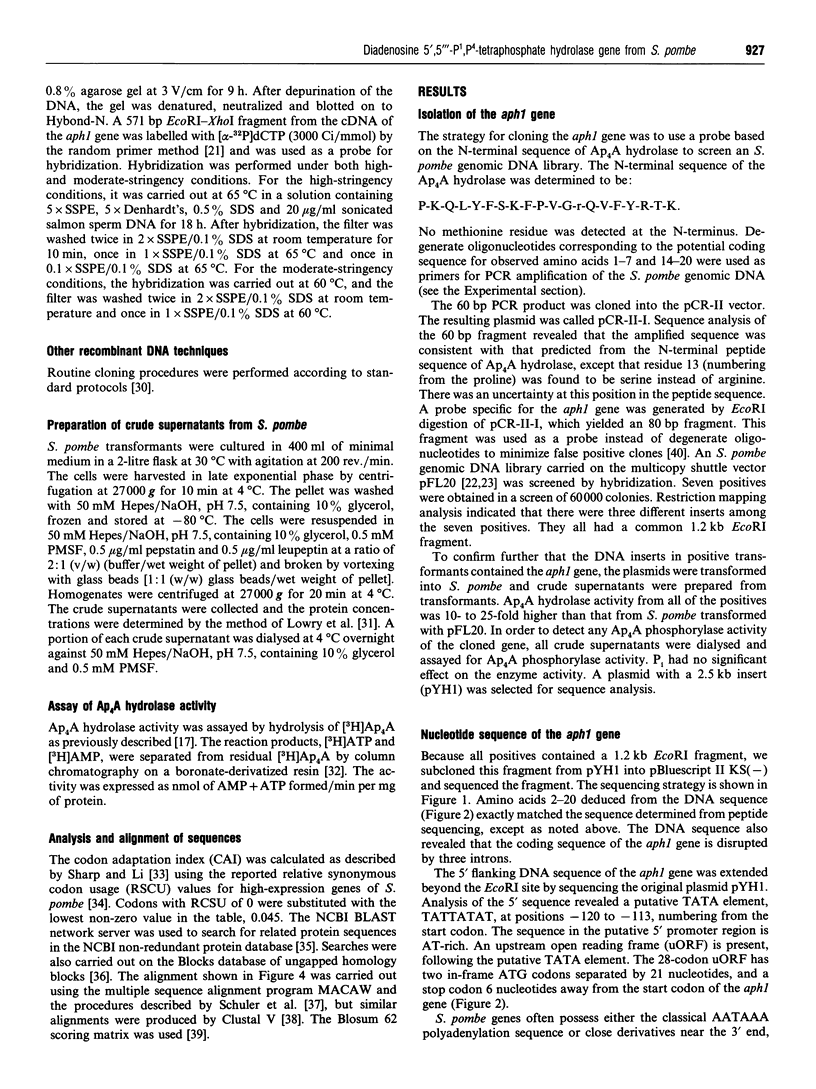
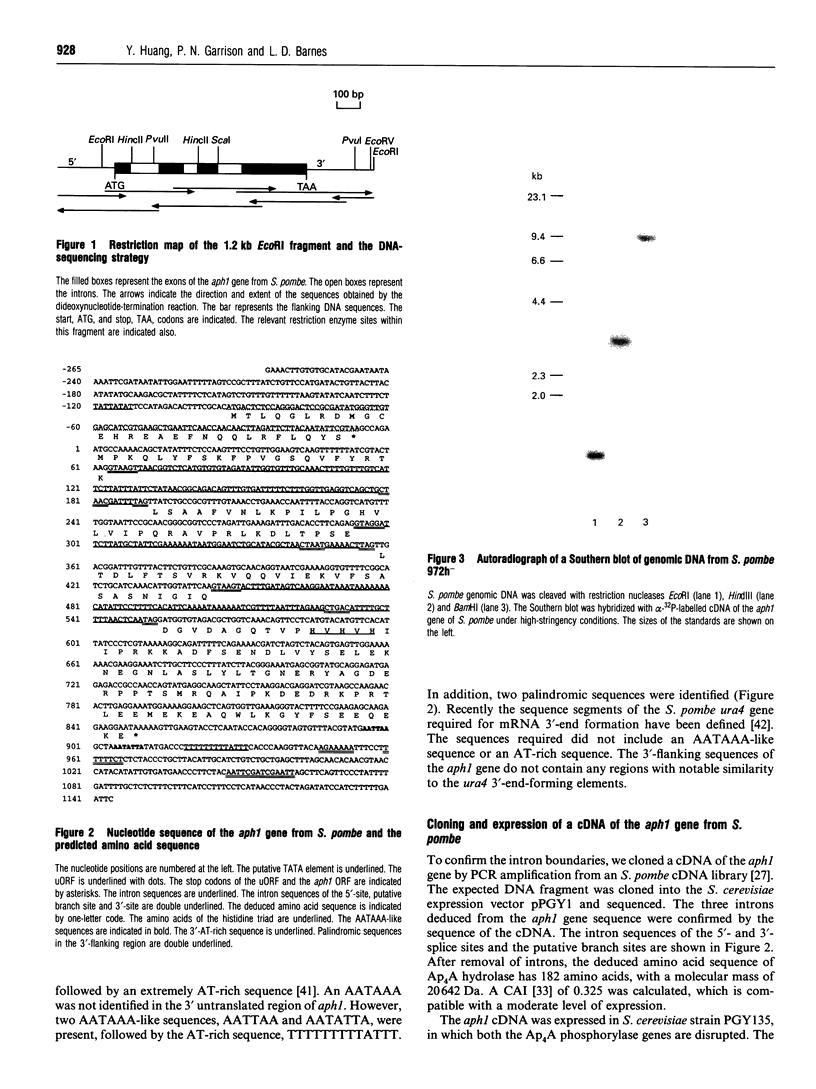
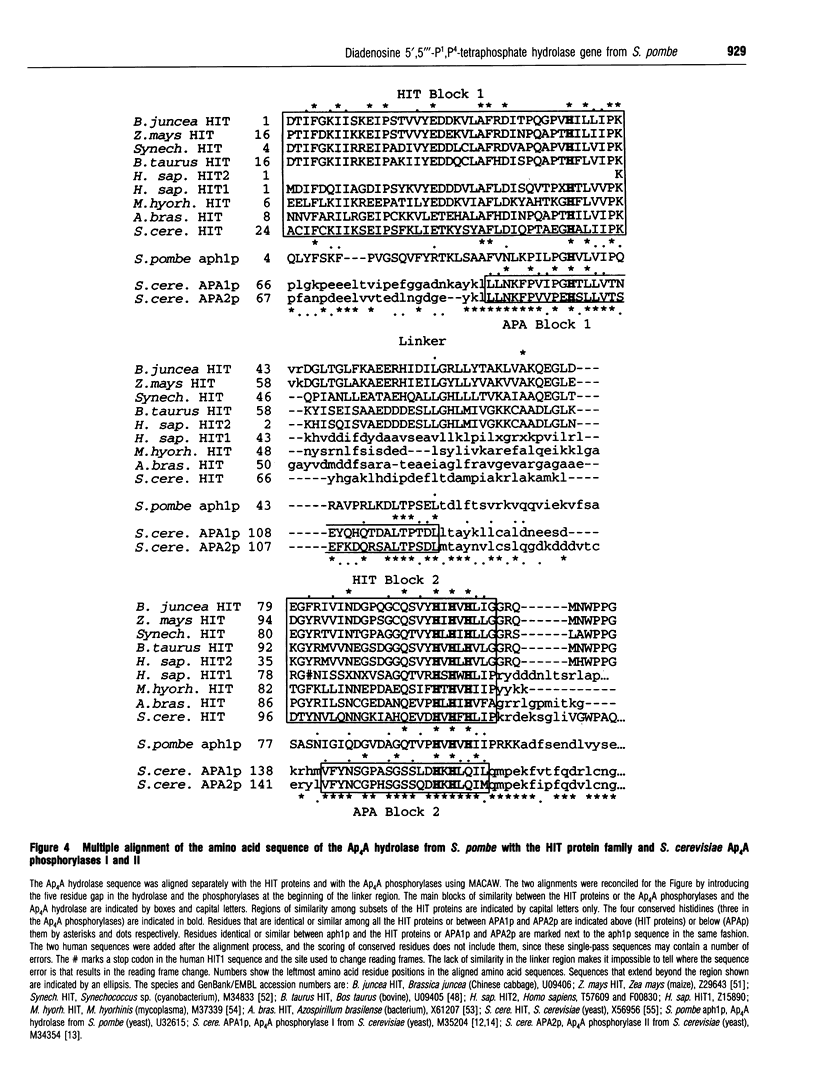
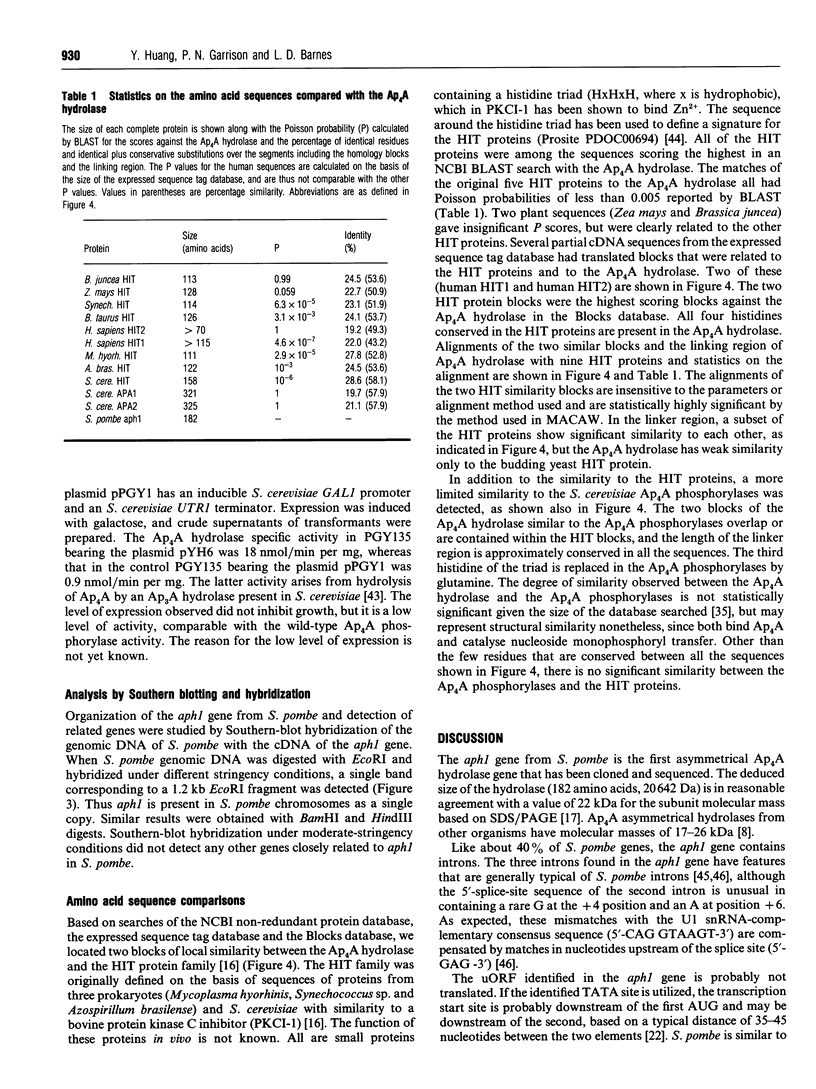
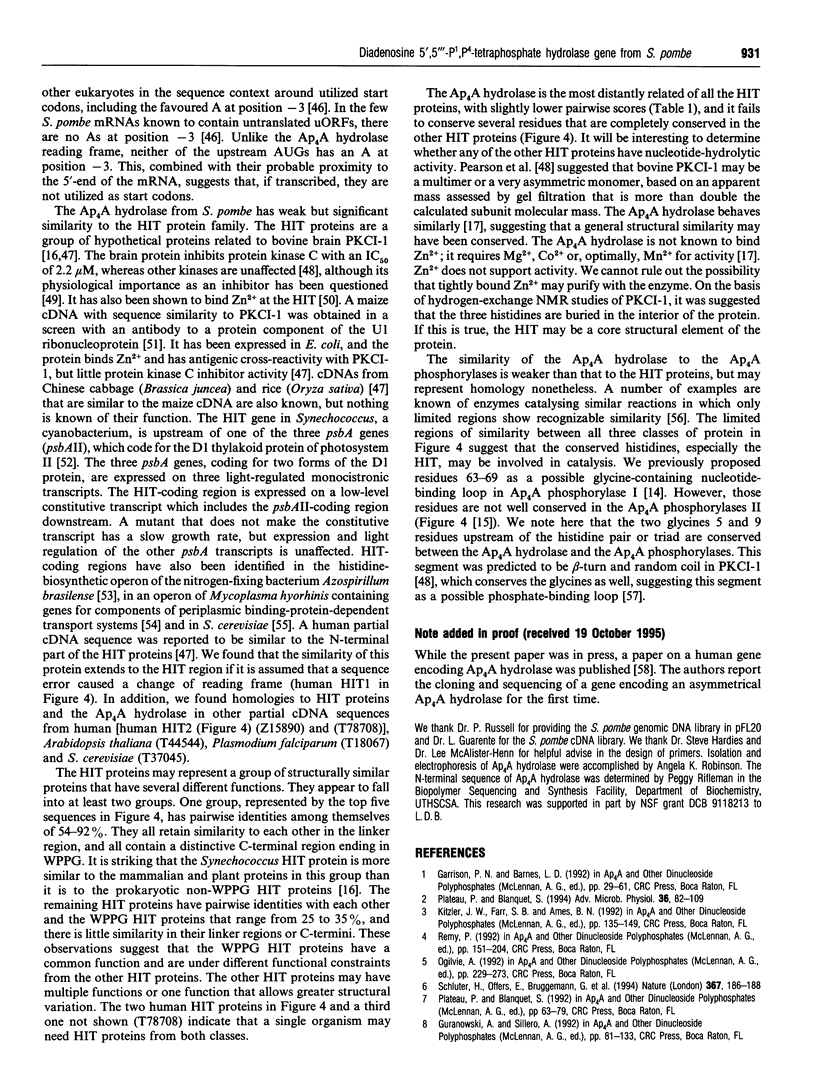
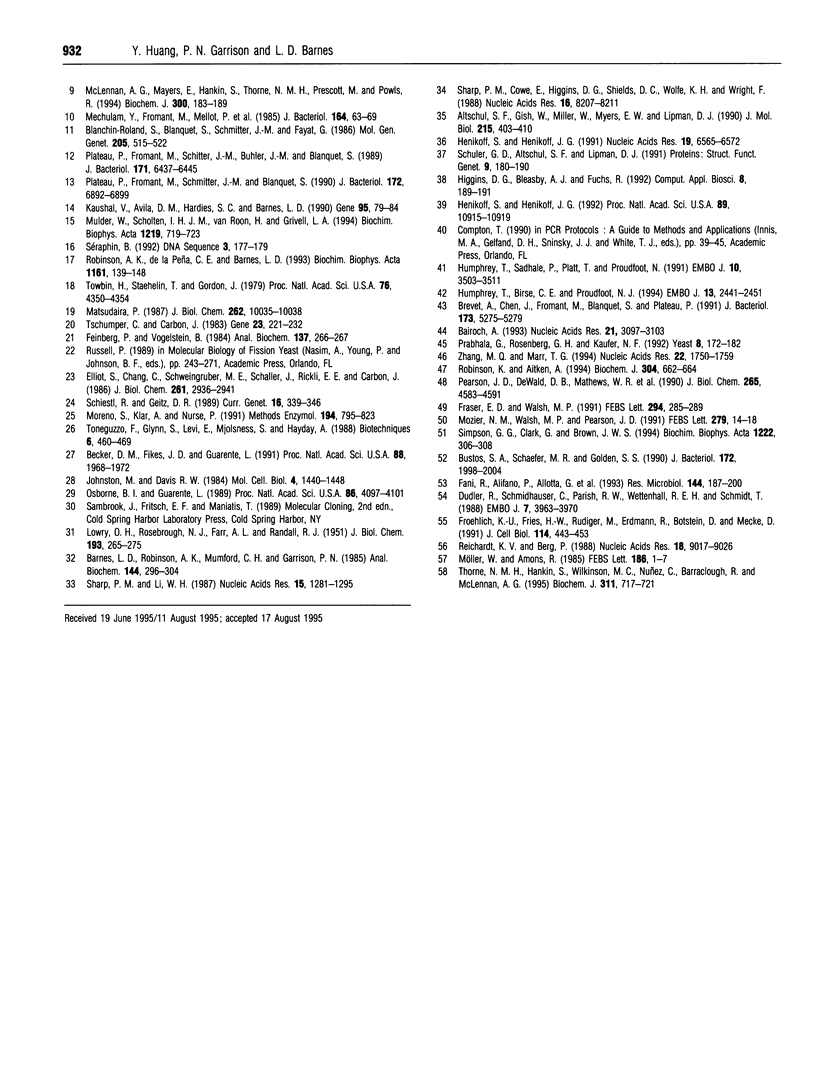
Images in this article
Selected References
These references are in PubMed. This may not be the complete list of references from this article.
- Altschul S. F., Gish W., Miller W., Myers E. W., Lipman D. J. Basic local alignment search tool. J Mol Biol. 1990 Oct 5;215(3):403–410. doi: 10.1016/S0022-2836(05)80360-2. [DOI] [PubMed] [Google Scholar]
- Bairoch A. The PROSITE dictionary of sites and patterns in proteins, its current status. Nucleic Acids Res. 1993 Jul 1;21(13):3097–3103. doi: 10.1093/nar/21.13.3097. [DOI] [PMC free article] [PubMed] [Google Scholar]
- Barnes L. D., Robinson A. K., Mumford C. H., Garrison P. N. Assay of diadenosine tetraphosphate hydrolytic enzymes by boronate chromatography. Anal Biochem. 1985 Jan;144(1):296–304. doi: 10.1016/0003-2697(85)90120-4. [DOI] [PubMed] [Google Scholar]
- Becker D. M., Fikes J. D., Guarente L. A cDNA encoding a human CCAAT-binding protein cloned by functional complementation in yeast. Proc Natl Acad Sci U S A. 1991 Mar 1;88(5):1968–1972. doi: 10.1073/pnas.88.5.1968. [DOI] [PMC free article] [PubMed] [Google Scholar]
- Blanchin-Roland S., Blanquet S., Schmitter J. M., Fayat G. The gene for Escherichia coli diadenosine tetraphosphatase is located immediately clockwise to folA and forms an operon with ksgA. Mol Gen Genet. 1986 Dec;205(3):515–522. doi: 10.1007/BF00338091. [DOI] [PubMed] [Google Scholar]
- Brevet A., Chen J., Fromant M., Blanquet S., Plateau P. Isolation and characterization of a dinucleoside triphosphatase from Saccharomyces cerevisiae. J Bacteriol. 1991 Sep;173(17):5275–5279. doi: 10.1128/jb.173.17.5275-5279.1991. [DOI] [PMC free article] [PubMed] [Google Scholar]
- Bustos S. A., Schaefer M. R., Golden S. S. Different and rapid responses of four cyanobacterial psbA transcripts to changes in light intensity. J Bacteriol. 1990 Apr;172(4):1998–2004. doi: 10.1128/jb.172.4.1998-2004.1990. [DOI] [PMC free article] [PubMed] [Google Scholar]
- Dudler R., Schmidhauser C., Parish R. W., Wettenhall R. E., Schmidt T. A mycoplasma high-affinity transport system and the in vitro invasiveness of mouse sarcoma cells. EMBO J. 1988 Dec 1;7(12):3963–3970. doi: 10.1002/j.1460-2075.1988.tb03283.x. [DOI] [PMC free article] [PubMed] [Google Scholar]
- Elliott S., Chang C. W., Schweingruber M. E., Schaller J., Rickli E. E., Carbon J. Isolation and characterization of the structural gene for secreted acid phosphatase from Schizosaccharomyces pombe. J Biol Chem. 1986 Feb 25;261(6):2936–2941. [PubMed] [Google Scholar]
- Fani R., Alifano P., Allotta G., Bazzicalupo M., Carlomagno M. S., Gallori E., Rivellini F., Polsinelli M. The histidine operon of Azospirillum brasilense: organization, nucleotide sequence and functional analysis. Res Microbiol. 1993 Mar-Apr;144(3):187–200. doi: 10.1016/0923-2508(93)90044-3. [DOI] [PubMed] [Google Scholar]
- Feinberg A. P., Vogelstein B. "A technique for radiolabeling DNA restriction endonuclease fragments to high specific activity". Addendum. Anal Biochem. 1984 Feb;137(1):266–267. doi: 10.1016/0003-2697(84)90381-6. [DOI] [PubMed] [Google Scholar]
- Fraser E. D., Walsh M. P. The major endogenous bovine brain protein kinase C inhibitor is a heat-labile protein. FEBS Lett. 1991 Dec 9;294(3):285–289. doi: 10.1016/0014-5793(91)81450-m. [DOI] [PubMed] [Google Scholar]
- Fröhlich K. U., Fries H. W., Rüdiger M., Erdmann R., Botstein D., Mecke D. Yeast cell cycle protein CDC48p shows full-length homology to the mammalian protein VCP and is a member of a protein family involved in secretion, peroxisome formation, and gene expression. J Cell Biol. 1991 Aug;114(3):443–453. doi: 10.1083/jcb.114.3.443. [DOI] [PMC free article] [PubMed] [Google Scholar]
- Henikoff S., Henikoff J. G. Amino acid substitution matrices from protein blocks. Proc Natl Acad Sci U S A. 1992 Nov 15;89(22):10915–10919. doi: 10.1073/pnas.89.22.10915. [DOI] [PMC free article] [PubMed] [Google Scholar]
- Henikoff S., Henikoff J. G. Automated assembly of protein blocks for database searching. Nucleic Acids Res. 1991 Dec 11;19(23):6565–6572. doi: 10.1093/nar/19.23.6565. [DOI] [PMC free article] [PubMed] [Google Scholar]
- Higgins D. G., Bleasby A. J., Fuchs R. CLUSTAL V: improved software for multiple sequence alignment. Comput Appl Biosci. 1992 Apr;8(2):189–191. doi: 10.1093/bioinformatics/8.2.189. [DOI] [PubMed] [Google Scholar]
- Humphrey T., Birse C. E., Proudfoot N. J. RNA 3' end signals of the S.pombe ura4 gene comprise a site determining and efficiency element. EMBO J. 1994 May 15;13(10):2441–2451. doi: 10.1002/j.1460-2075.1994.tb06529.x. [DOI] [PMC free article] [PubMed] [Google Scholar]
- Humphrey T., Sadhale P., Platt T., Proudfoot N. Homologous mRNA 3' end formation in fission and budding yeast. EMBO J. 1991 Nov;10(11):3503–3511. doi: 10.1002/j.1460-2075.1991.tb04914.x. [DOI] [PMC free article] [PubMed] [Google Scholar]
- Johnston M., Davis R. W. Sequences that regulate the divergent GAL1-GAL10 promoter in Saccharomyces cerevisiae. Mol Cell Biol. 1984 Aug;4(8):1440–1448. doi: 10.1128/mcb.4.8.1440. [DOI] [PMC free article] [PubMed] [Google Scholar]
- Kaushal V., Avila D. M., Hardies S. C., Barnes L. D. Sequencing and enhanced expression of the gene encoding diadenosine 5',5'''-P1, P4-tetraphosphate (Ap4A) phosphorylase in Saccharomyces cerevisiae. Gene. 1990 Oct 30;95(1):79–84. doi: 10.1016/0378-1119(90)90416-o. [DOI] [PubMed] [Google Scholar]
- LOWRY O. H., ROSEBROUGH N. J., FARR A. L., RANDALL R. J. Protein measurement with the Folin phenol reagent. J Biol Chem. 1951 Nov;193(1):265–275. [PubMed] [Google Scholar]
- Matsudaira P. Sequence from picomole quantities of proteins electroblotted onto polyvinylidene difluoride membranes. J Biol Chem. 1987 Jul 25;262(21):10035–10038. [PubMed] [Google Scholar]
- McLennan A. G., Mayers E., Hankin S., Thorne N. M., Prescott M., Powls R. The green alga Scenedesmus obliquus contains both diadenosine 5',5'''-P1,P4-tetraphosphate (asymmetrical) pyrophosphohydrolase and phosphorylase activities. Biochem J. 1994 May 15;300(Pt 1):183–189. doi: 10.1042/bj3000183. [DOI] [PMC free article] [PubMed] [Google Scholar]
- Mechulam Y., Fromant M., Mellot P., Plateau P., Blanchin-Roland S., Fayat G., Blanquet S. Molecular cloning of the Escherichia coli gene for diadenosine 5',5'''-P1,P4-tetraphosphate pyrophosphohydrolase. J Bacteriol. 1985 Oct;164(1):63–69. doi: 10.1128/jb.164.1.63-69.1985. [DOI] [PMC free article] [PubMed] [Google Scholar]
- Moreno S., Klar A., Nurse P. Molecular genetic analysis of fission yeast Schizosaccharomyces pombe. Methods Enzymol. 1991;194:795–823. doi: 10.1016/0076-6879(91)94059-l. [DOI] [PubMed] [Google Scholar]
- Mozier N. M., Walsh M. P., Pearson J. D. Characterization of a novel zinc binding site of protein kinase C inhibitor-1. FEBS Lett. 1991 Feb 11;279(1):14–18. doi: 10.1016/0014-5793(91)80238-x. [DOI] [PubMed] [Google Scholar]
- Mulder W., Scholten I. H., van Roon H., Grivell L. A. Isolation and characterisation of the linked genes APA2 and QCR7, coding for Ap4A phosphorylase II and the 14 kDa subunit VII of the mitochondrial bc1-complex in the yeast Kluyveromyces lactis. Biochim Biophys Acta. 1994 Nov 22;1219(3):719–723. doi: 10.1016/0167-4781(94)90235-6. [DOI] [PubMed] [Google Scholar]
- Osborne B. I., Guarente L. Mutational analysis of a yeast transcriptional terminator. Proc Natl Acad Sci U S A. 1989 Jun;86(11):4097–4101. doi: 10.1073/pnas.86.11.4097. [DOI] [PMC free article] [PubMed] [Google Scholar]
- Pearson J. D., DeWald D. B., Mathews W. R., Mozier N. M., Zürcher-Neely H. A., Heinrikson R. L., Morris M. A., McCubbin W. D., McDonald J. R., Fraser E. D. Amino acid sequence and characterization of a protein inhibitor of protein kinase C. J Biol Chem. 1990 Mar 15;265(8):4583–4591. [PubMed] [Google Scholar]
- Plateau P., Blanquet S. Dinucleoside oligophosphates in micro-organisms. Adv Microb Physiol. 1994;36:81–109. doi: 10.1016/s0065-2911(08)60177-0. [DOI] [PubMed] [Google Scholar]
- Plateau P., Fromant M., Schmitter J. M., Blanquet S. Catabolism of bis(5'-nucleosidyl) tetraphosphates in Saccharomyces cerevisiae. J Bacteriol. 1990 Dec;172(12):6892–6899. doi: 10.1128/jb.172.12.6892-6899.1990. [DOI] [PMC free article] [PubMed] [Google Scholar]
- Plateau P., Fromant M., Schmitter J. M., Buhler J. M., Blanquet S. Isolation, characterization, and inactivation of the APA1 gene encoding yeast diadenosine 5',5'''-P1,P4-tetraphosphate phosphorylase. J Bacteriol. 1989 Dec;171(12):6437–6445. doi: 10.1128/jb.171.12.6437-6445.1989. [DOI] [PMC free article] [PubMed] [Google Scholar]
- Prabhala G., Rosenberg G. H., Käufer N. F. Architectural features of pre-mRNA introns in the fission yeast Schizosaccharomyces pombe. Yeast. 1992 Mar;8(3):171–182. doi: 10.1002/yea.320080303. [DOI] [PubMed] [Google Scholar]
- Reichardt J. K., Berg P. Conservation of short patches of amino acid sequence amongst proteins with a common function but evolutionarily distinct origins: implications for cloning genes and for structure-function analysis. Nucleic Acids Res. 1988 Sep 26;16(18):9017–9026. doi: 10.1093/nar/16.18.9017. [DOI] [PMC free article] [PubMed] [Google Scholar]
- Robinson A. K., de la Peña C. E., Barnes L. D. Isolation and characterization of diadenosine tetraphosphate (Ap4A) hydrolase from Schizosaccharomyces pombe. Biochim Biophys Acta. 1993 Feb 13;1161(2-3):139–148. doi: 10.1016/0167-4838(93)90207-8. [DOI] [PubMed] [Google Scholar]
- Robinson K., Aitken A. Identification of a new protein family which includes bovine protein kinase C inhibitor-1. Biochem J. 1994 Dec 1;304(Pt 2):662–664. doi: 10.1042/bj3040662. [DOI] [PMC free article] [PubMed] [Google Scholar]
- Schiestl R. H., Gietz R. D. High efficiency transformation of intact yeast cells using single stranded nucleic acids as a carrier. Curr Genet. 1989 Dec;16(5-6):339–346. doi: 10.1007/BF00340712. [DOI] [PubMed] [Google Scholar]
- Schlüter H., Offers E., Brüggemann G., van der Giet M., Tepel M., Nordhoff E., Karas M., Spieker C., Witzel H., Zidek W. Diadenosine phosphates and the physiological control of blood pressure. Nature. 1994 Jan 13;367(6459):186–188. doi: 10.1038/367186a0. [DOI] [PubMed] [Google Scholar]
- Schuler G. D., Altschul S. F., Lipman D. J. A workbench for multiple alignment construction and analysis. Proteins. 1991;9(3):180–190. doi: 10.1002/prot.340090304. [DOI] [PubMed] [Google Scholar]
- Sharp P. M., Cowe E., Higgins D. G., Shields D. C., Wolfe K. H., Wright F. Codon usage patterns in Escherichia coli, Bacillus subtilis, Saccharomyces cerevisiae, Schizosaccharomyces pombe, Drosophila melanogaster and Homo sapiens; a review of the considerable within-species diversity. Nucleic Acids Res. 1988 Sep 12;16(17):8207–8211. doi: 10.1093/nar/16.17.8207. [DOI] [PMC free article] [PubMed] [Google Scholar]
- Sharp P. M., Li W. H. The codon Adaptation Index--a measure of directional synonymous codon usage bias, and its potential applications. Nucleic Acids Res. 1987 Feb 11;15(3):1281–1295. doi: 10.1093/nar/15.3.1281. [DOI] [PMC free article] [PubMed] [Google Scholar]
- Simpson G. G., Clark G., Brown J. W. Isolation of a maize cDNA encoding a protein with extensive similarity to an inhibitor of protein kinase C and a cyanobacterial open reading frame. Biochim Biophys Acta. 1994 Jun 30;1222(2):306–308. doi: 10.1016/0167-4889(94)90183-x. [DOI] [PubMed] [Google Scholar]
- Séraphin B. The HIT protein family: a new family of proteins present in prokaryotes, yeast and mammals. DNA Seq. 1992;3(3):177–179. doi: 10.3109/10425179209034013. [DOI] [PubMed] [Google Scholar]
- Thorne N. M., Hankin S., Wilkinson M. C., Nuñez C., Barraclough R., McLennan A. G. Human diadenosine 5',5"'-P1,P4-tetraphosphate pyrophosphohydrolase is a member of the MutT family of nucleotide pyrophosphatases. Biochem J. 1995 Nov 1;311(Pt 3):717–721. doi: 10.1042/bj3110717. [DOI] [PMC free article] [PubMed] [Google Scholar]
- Toneguzzo F., Glynn S., Levi E., Mjolsness S., Hayday A. Use of a chemically modified T7 DNA polymerase for manual and automated sequencing of supercoiled DNA. Biotechniques. 1988 May;6(5):460–469. [PubMed] [Google Scholar]
- Towbin H., Staehelin T., Gordon J. Electrophoretic transfer of proteins from polyacrylamide gels to nitrocellulose sheets: procedure and some applications. Proc Natl Acad Sci U S A. 1979 Sep;76(9):4350–4354. doi: 10.1073/pnas.76.9.4350. [DOI] [PMC free article] [PubMed] [Google Scholar]
- Tschumper G., Carbon J. Copy number control by a yeast centromere. Gene. 1983 Aug;23(2):221–232. doi: 10.1016/0378-1119(83)90054-9. [DOI] [PubMed] [Google Scholar]
- Zhang M. Q., Marr T. G. Fission yeast gene structure and recognition. Nucleic Acids Res. 1994 May 11;22(9):1750–1759. doi: 10.1093/nar/22.9.1750. [DOI] [PMC free article] [PubMed] [Google Scholar]



